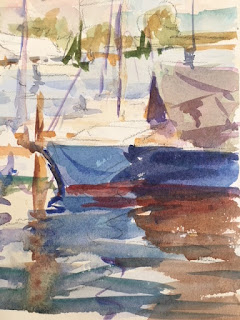It was a small workshop. I titled it "Color Boot Camp".
I think the reason I teach is to learn more about painting and color. I explore how color works, how color is expressed, how to see color.
I start each session with a short demo to put the idea across.
It's important in learning outdoor color to be able to express light key, (sunny morning ) by making a simple study of warms and cool colors coming together.
 |
| Sky, and Water Demo |
In the afternoon I made another sunny day demonstration. This time expressing a water scene. The two most difficult things to understand is sky and water. They both have atmosphere and light. Painting them blue or green only expresses local color. It doesn't get specific pertaining to time of day or light key.
 |
| Heritage Village |
The second day we had the chance to paint at the Heritage Village, a 21 acre living history museum. The pine and palmetto landscape features some of Pinellas County's most historic buildings. The Village park was a wonderful place to paint architecture and landscape.
 |
| White House in Sunlight |
The morning demo was concerning white in the light and white in the shade. Most artist's don't conceder making the white a color other than gray. I tell artist's to make simple studies of blocks in sunlight and try and get the color of white in relation to all the other color blocks.
In the afternoon I did a demonstration of values and warm and cool colors. Using a split compliment color combination, of Orange, Cobalt Blue and Cadmium yellow deep; I have a limited palette that can express simple warms and cools.
 |
| Values Top Split Complements on the bottom |
In the second study, the split compliments forced me to make greens rather than depending on green oil paint.

































